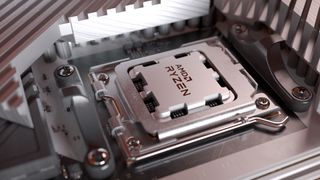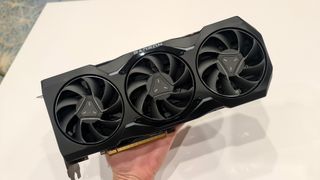AMD: Moore's Law ain't dead, it's just a whole lot more expensive
Faster PCs will keep on coming, but creating them is becoming ever more complex.

AMD chief technology officer Mark Papermaster has good news: Moore's Law isn't dead. CPUs and GPUs will keep getting better for the foreseeable future. But he also has bad news. It's becoming more and more expensive to keep it all on track, forcing innovative solutions such as chiplet designs.
Moore’s Law, of course, is the observation that transistor densities in integrated circuits double every two years. Posited in 1965 by Intel co-founder Gordon Moore, it originally plotted a yearly cadence for density doubling before Moore revised the schedule to every two years in 1975. There it has stayed ever since and it has proven remarkable prescient, to this very day.
Speaking at a summit in Las Vegas, Papermaster explained that Moore's Law is still on track, but chip technologies are becoming ever more complex.
"And you've all heard many times Moore's Law is slowing down. Moore's Law is dead," Papermaster says. But according to AMD's tech guru, that's not actually true.
"It's not that there's not going to be exciting new transistor technologies. Actually, I can see exciting new transistor technology for the next—as far as you can really plot these things out, is about six to eight years, and it's very, very clear to me the advances that we're going to make to keep improving the transistor technology, but they're more expensive."
The difference now, Papermaster explains, is that where you used to get double the transistor density every same year while costs remained largely the same for a given chip size, the cost per area of silicon is increasing with each successive production node. Computer chips of a given size are becoming much more expensive.
Papermaster says AMD saw that coming, which was a key driver in its move to chiplet designs for its CPUs several years ago, and then again for GPUs with RDNA 3 earlier this year. If chiplets are one part of the solution to rising silicon production prices, piecing together combinations of old school CPUs and GPUs with specialized accelerators will be ever more important.
The biggest gaming news, reviews and hardware deals
Keep up to date with the most important stories and the best deals, as picked by the PC Gamer team.

"You're going to have to use accelerators," Papermaster says, "GPU acceleration, specialized function units, and adaptive compute like we acquired with Xilinx. You're going to see tremendous innovation on how those come together and it really will keep us on pace."
In other words, while transistor densities keep on rising in line with Moore's Law, the chips are getting more expensive, forcing companies like AMD to use chiplets to increase yields and therefore stop costs from spiralling. Specialized circuitry also tends to be much more compact than general purposed CPU and GPU blocks, enabling performance to ramp without the price penalty that would entail from a traditional pure CPU or GPU design.

Best CPU for gaming: The top chips from Intel and AMD
Best gaming motherboard: The right boards
Best graphics card: Your perfect pixel-pusher awaits
Best SSD for gaming: Get into the game ahead of the rest
In recent years, the imminent demise of Moore's Law has been widely reported. Partly that's down to the conspicuous struggles of the former king of chip production tech, Intel. But Intel isn't the only chip maker and while it has certainly fallen behind, at the leading edge TSMC has kept Moore's Law absolutely on track.
It is, of course, TSMC that makes AMD's CPUs and GPUs, not to mention Nvidia's latest GPUs and Apple's M1 chips. Right now, TSMC's 5nm node, as seen in AMD's CPUs and GPUs, is roughly one generation ahead of Intel's 10nm node, recently rebranded Intel 7.
TSMC has also just started 3nm production, with devices using TSMC 3nm silicon expected to hit the market in the first half of 2023, mostly likely in the form of an Apple Mac computer running a 3nm derivative of its M1 and M2 chips. TSMC then expects to have 2nm production coming on line in 2025. For now, then, Moore's Law looks healthy enough. It's just become a bit more high maintenance.

Jeremy has been writing about technology and PCs since the 90nm Netburst era (Google it!) and enjoys nothing more than a serious dissertation on the finer points of monitor input lag and overshoot followed by a forensic examination of advanced lithography. Or maybe he just likes machines that go “ping!” He also has a thing for tennis and cars.
Most Popular






